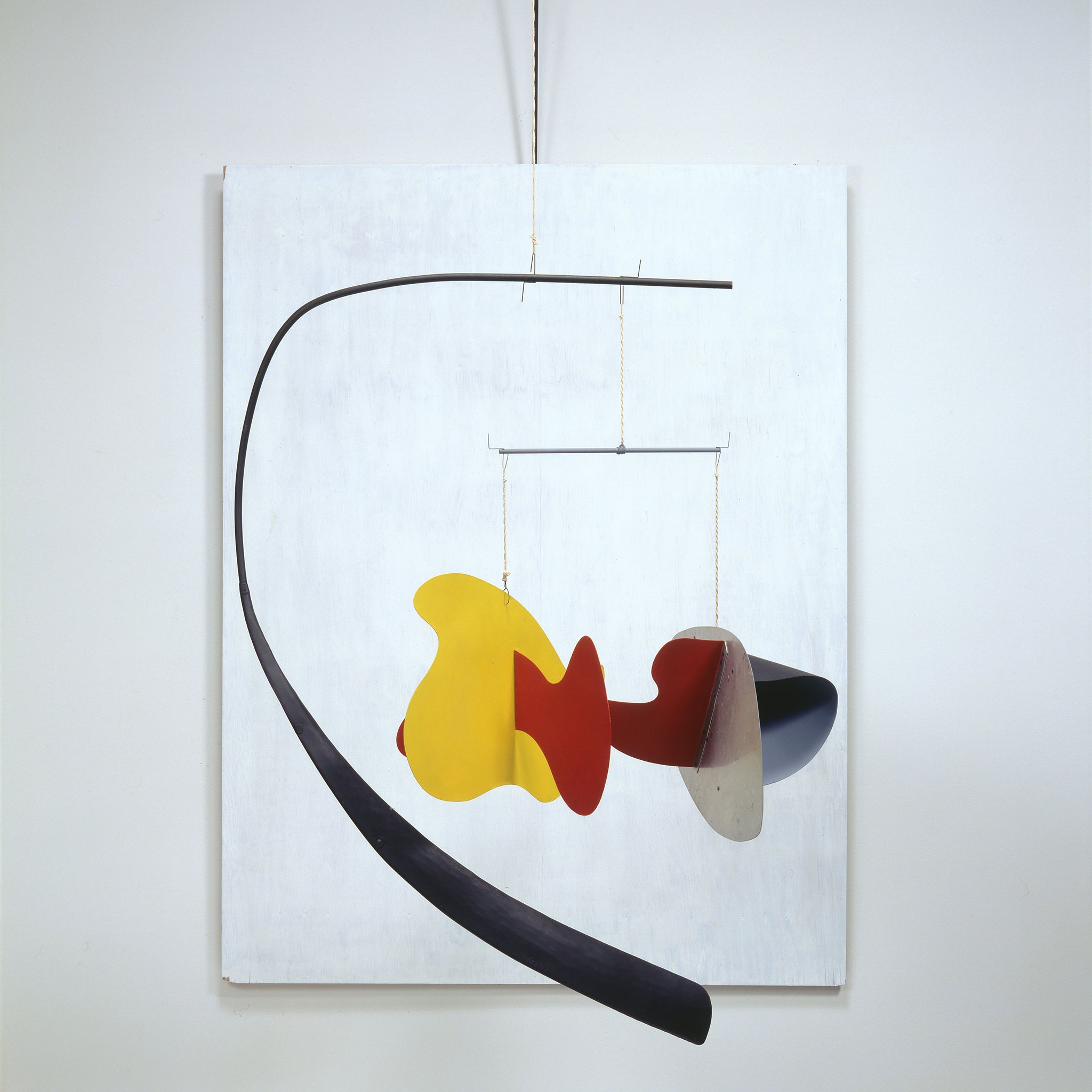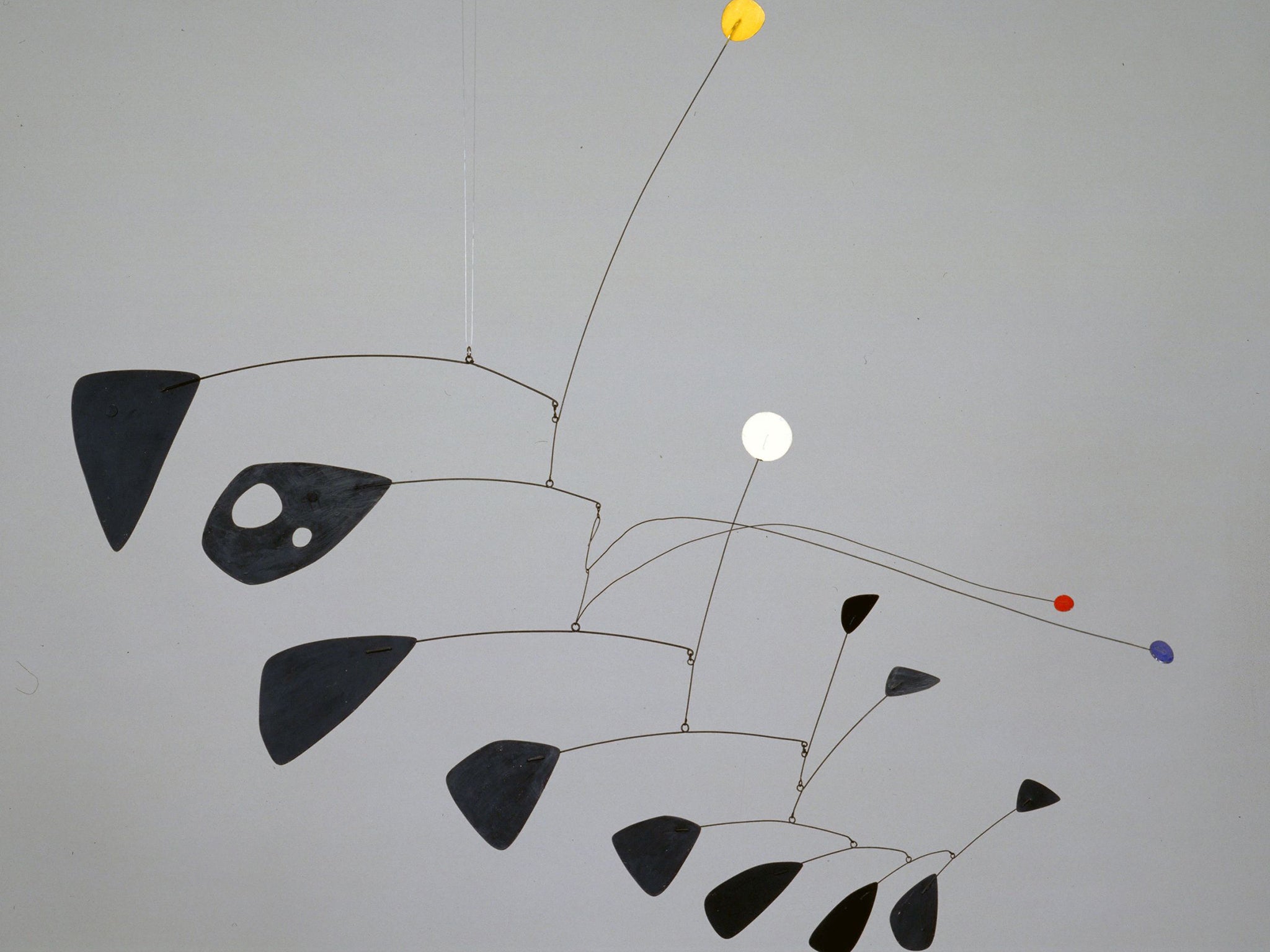Alexander Calder: As his mobiles fill up Tate Modern, artist's grandson explains why they are more than just toys
Like a dance or a play or a piece of live music, a moment with a mobile can never be repeated exactly - each is unique

With their bright colours, delicate motion, and abstract playfulness, Alexander Calder’s mobiles ignite a childish delight in the viewer; many of the American sculptor’s other famous works – a performable model circus, wire sculptures of acrobats, dancers or animals – have also given rise to the perception of a particularly jolly artist. His studio, one imagines, would have been a treasure trove for a child.
Yes and no, says his grandson. Sandy Rower has spent the last 27 years dedicated to his grandfather’s legacy, establishing the Calder Foundation who restore, loan and advise on his work; they’ve been key in helping put together the new Tate Modern blockbuster Calder show. But Rower can also draw on a store of more personal childhood memories.
“I was in his studio all the time,” he says over lunch at the Foundation in New York. “I was very welcomed in the studio. My brother and I would go and make stuff - when you’re a kid you want to make a sword, you don’t want to make a sculpture, per se. He showed me how to hold a chisel, cut a sheet of steel, hit it with a hammer… But he wasn’t a funny guy in the studio - at (itals)all. If you did something screwy, you’d be kicked out in a micro-second. You were expected to be hard at work.”
As for the famous Calder Circus – not on loan to the show, as its characterful wire figures are so delicate - that certainly wasn’t a toy. It was a work of art: an early, perhaps even the earliest, example of performance art, Rower posits, the figures brought to life meticulously by his grandfather.
Maybe it’s because Rower’s been taking his grandfather’s work seriously since he was a little boy, but he now considers that Calder’s perceived accessibility a double-edged sword. “His popularity is extreme, and it’s a bit of a curse.”

Surely, the public loving your work can only be a good thing? But Rower suggests that, historically, Calder’s ethereally light works have been treated as, well, lightweight. “There was such a diminishment of his intelligence… Calder was rejected by critics in the Sixties and Seventies because of the ease of appreciation. That art should just be ‘fun’ is a complete misunderstanding about what he was trying to achieve. We have to hold the flame over here and ask for a little bit more rigour about his ideas.”
The fun takes care of itself, he adds - even if you do a “super over-intellectual exhibition”, the viewer would still be in thrall to the splashed colour, the energetic forms, the sheer beauty of the mobiles. Lucky, then, that the Tate isn’t mounting Calder: the fun years.
Their exhibition takes a more cerebral, conceptual approach. Rather than a retrospective, the show - titled Alexander Calder: Performing Sculpture - traces movement and performance within his work. It suggests that, thanks to their kinetic energy, every encounter with Calder’s moving sculptures is like a one-off performance.
“It’s not a retrospective, it’s a discussion about how his work is present,” says Rower. “Calder starts to refer [in the 1930s] to choreography: it’s a person spinning around and you have an emotional response to it – why? He’s trying to get to the central nature of that, without telling a story. Motion is the subject.”
And motion is there right throughout his work. It’s there in a 1929 wire sculptures of two acrobats – when we see them at the Foundation, Rower gives them a gentle touch, and they quiver and shake in their perpetually held pose. It’s there in early motorised kinetic sculptures – wire fish bobbing in a wire tank (1929), or a ball moving up and down in front of a black screen, abstraction arriving as the movement of colour and form through space.
“What we’re getting at is motion in real time: it’s 2015 and we’re experiencing his piece from 1931. The experience is the key - and it’s the key to the mobiles too,” says Rower. He talks up the contrast between the ever-changing immediacy of the moving works with a finished painting, a fixed document of its own historical moment of creation.
Motion becomes freer and more fluid in Calder’s panel works: against eye-poppingly bright backdrops, biomorphic or geometric shapes hang and slowly twirl in space. Some of these are set to startle the Calder super-fan or scholar, with the Tate show featuring works that haven’t been exhibited in many decades. And they’re utterly gorgeous.
Finally, the famous mobiles – strung on delicate wires, colourful metal petals slowly turn and glide through the air. In a real coup, the final work of the Tate’s show will be Black Widow, a monumental 12 foot sculpture never before seen in Britain; Calder made it for an architectural institute in Brazil in 1948. Getting it to the foundation for major restoration work – and then on to the Tate – has been an equivalently monumental achievement involving, Rower only half-jokes, “foreign affairs and international politics”.
Black Widow will have a whole room to itself – the final “performance” of the show. Highly sensitive to tiny changes in the atmosphere around them, Calder’s mobiles dance with the viewer – slowly, gracefully, their turnings and driftings altered by the mere presence of people. The heat and humidity of human bodies, their breath or laughter, change the air currents and the motion.
And the Tate show is set to emphasise the unique and live aspect of all this. I stood in front of Black Widow in New York, walked round her, peered at her dark petals. But your experience will be entirely different. Like a dance or a play or a piece of live music – and Calder did also create works for more formalised stage performances – a moment with a mobile can never be repeated exactly. Each is unique.
This interactive element is, however, troublesome for those who want to show his work. Oh, how tempting it is to reach out and touch the mobiles – to set off new spirals of movement. Which is not something that fills the owners of these extremely collectable works with delight…
“The general public doesn’t leave a thumbprint on a painting, but everyone wants to touch or blow a Calder mobile - and the people that own them don’t want the public spitting on them by accident…” acknowledges Rower laconically. “How do you present Calder’s work as he intended it to be experienced, and yet preserve and protect it? It’s a huge problem for us.”
The public may have to keep their hands to themselves, but the Tate is also exhibiting an astonishing work of literal performance, where four percussionists get to do what gallery visitors yearn to: they literally play a Calder mobile.
In 1963, Calder collaborated with composer Earle Brown, making Chef d’orchestre, a mobile that is also a conductor, its differing movements instructing musicians on how to play over 100 different percussion instruments.
“My grandfather pushes it further, and thought that the mobile shouldn’t just conduct – but should actually be a percussion instrument itself. The four percussionists would strike the mobile, which was tuned to play music. And the harder you hit it, the louder and faster it goes. I last saw [Calder Piece] two decades ago, it’s never performed. The object is now owned by a collector who believes it’s a sculpture instead of an instrument – it looks like a multi-million dollar Calder, so persuading him to bring it to England to be hit by a bunch of people with hammers was a real challenge!” Of course, Rower adds, this mobile actually is both: a sculpture and a musical instrument. A piece of art, that performs.
Alexander Calder: Performing Sculpture is at the Tate Modern, 11 Nov to 3 Apr
Join our commenting forum
Join thought-provoking conversations, follow other Independent readers and see their replies
Comments